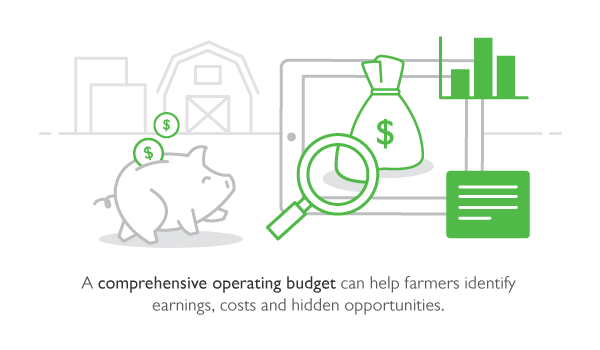Instinct and experience can go a long way toward managing a successful farm. But there’s no substitute for a methodical, well-recorded operating budget. Financial tidiness can help farmers have a better grasp on what they can and cannot afford, but also what they should spend money on when they have change to spare.
An operating budget can also provide hints of how you should be using your land based on a comparison of profit to the total cost of goods sold. While you may intuitively understand what your real bread winners are, knowing the precise extent of your losses and earnings can show you hidden opportunities that might otherwise slip between the cracks.

Building an operating budget
At the most basic level, every farm manager can benefit from creating an enterprise budget for each of its core operations. The purpose is to reveal, with real numbers, the costs and revenues of the main operations within your farm (livestock, crop farming, foraging, agro-tourism, etc.). From here you can get a sense of which operations are the most lucrative, which are losing money and why, and then take action accordingly.
More precisely, it makes sense to:
- Create a budget at the beginning of the year (or season) projecting your costs and revenues for each of your core operations.
- Track your actual costs and revenues throughout the year and then compare them at the end.
- Analyze the discrepancies to get insight into where you fell short and where expectations were exceeded.
This exercise can reveal nuances that can help you more accurately forecast your cost and revenue in the following year. The ability to project your earnings more precisely may ultimately be useful for understanding cash flow – that is, your understanding of the amount of cash coming in and going out of your farm.
When building an operating budgeting, some of the main expenses and earnings to consider include:
- Expenses: Equipment, machinery, fuel, utilities, office expenses, marketing, permits, property taxes, insurance, interest and any discretionary spending.
- Cost of goods sold: Any costs that is more directly tied to the sale of a certain good; for instance, purchasing seeds or seedlings would fall under COGS.
- Labor: Costs tied to staffing workers, including any wages, benefits and taxes. Don’t forget about your own salary, either.
- Income: Any money coming in as a result of your operations after taxes.
If you do this for each of your core operations, you can begin to get a sense of your most and least profitable ventures. You can combine your total expenses and income for each of the operations to then get a bigger picture of your farm’s financial performance.
Farm management is financial management
Knowing what your assets and your operations are worth can help you understand the value (and potential value) of your farm in a much more granular way. And, at the end of the day, financial management is really just the management of that value. In this sense, every farm manager is also a financial manager of sorts.
As daunting as farm finances may seem at first, they’re necessary for the long-term vitality of your operations. There are plenty of stepping stones to get you started, including Agricultural Marketing Resource Center tools to help you on your way to better budgeting.
And if that’s not enough, rest assured, you can reach out to the ag finance experts at Bank Midwest any time for assistance.
